5 Chair Exercises That Shrink Your Stomach Pooch Faster Than Crunches After 50
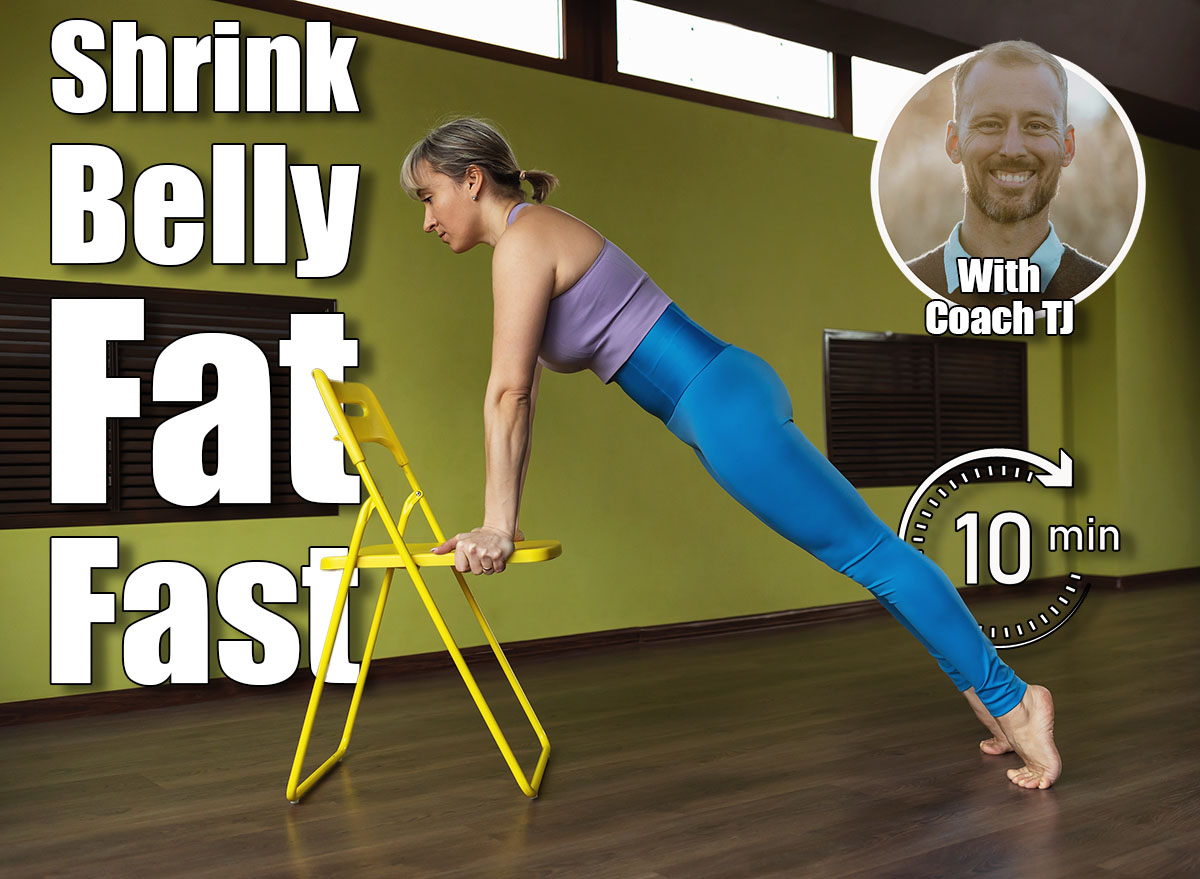
Hitting 50 comes with many perks—wisdom, confidence, and freedom—but it also brings stubborn belly fat that seems immune to traditional crunches. Your metabolism has slowed, hormones have shifted, and your body just doesn’t respond like it used to in your 30s.
The good news is that you don’t need to get on the floor or hit the gym to start seeing real results. These five chair exercises will help you target that stomach pooch more effectively than endless crunches, all from the comfort of your own home.
Why Your Belly Fat Became So Stubborn After 50
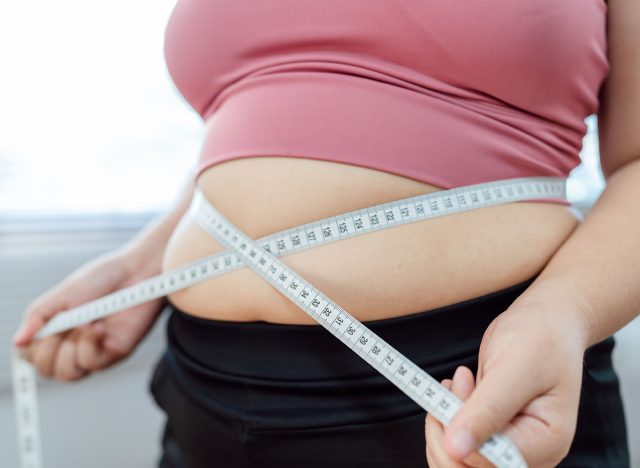
Once we cross 50, a few big shifts happen in our bodies:
- Our hormones, especially estrogen and testosterone, decline
- With this decline comes a slowing of our overall metabolism
- Muscle mass naturally decreases if we’re not actively training
- Less muscle means fewer calories burned at rest and less ability to store glucose
Additionally, when you look at years of stress, disrupted sleep, and the tendency to move less as joints get stiff and careers require more of our time, belly fat becomes far more stubborn than it was in our 30s.
The biggest challenge isn’t just controlling our calories—it’s that the body isn’t as metabolically efficient as it used to be. This means it takes more intentional movement and smarter choices to shed our excess body fat.
Why Chair Exercises Work So Well for Your Stomach Pooch
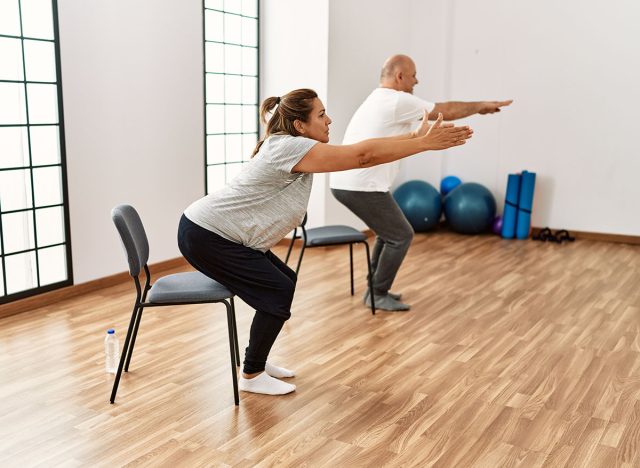
Chair exercises can be great for those over 50, targeting their stomach pooch for several key reasons:
- They’re widely available: Maybe you can’t always make it to the gym, but you almost certainly always have a chair around
- Easy modifications: Chairs allow us to modify exercises quickly and efficiently. If one exercise is too challenging, you can easily use the chair to make it easier and vice versa
- No floor work needed: For some people, it can be challenging to get up and down from the floor, perhaps due to loss of range of motion from a sedentary lifestyle or an acute injury
Either way, a chair can be a great tool to get you back in the game.
5 Chair Exercises to Shrink Belly Fat After 50
The TVA (Transverse Abdominis) Draw In
The transverse abdominis, or the TVA, is the deepest layer of our abdominal musculature. It’s the muscle that is responsible for pulling your belly button in towards the spine.
This muscle is functioning anytime we lift a heavy enough load that we need it to stabilize the spine. It is also functioning during bowel movements. I know that’s not something people generally like to discuss, but the reality is that a functioning TVA can really help with the digestive system.
A healthy digestive system cannot only help us have better overall health, but it can also reduce the amount that our gut sticks out simply by maintaining a better tone of the abdominal wall.
How to do it:
- Sit up nice and tall in your chair with your hands gently resting in your lap
- Take a big breath in and let your belly expand
- When you’re ready to exhale, slowly pull your belly button into your spine until you have exhaled all of your air
- Maintain the belly button pulled into your spine until you are ready to inhale again
- Relax the belly to fully inhale • Repeat this for 8 to 10 repetitions
Common mistakes:
- Holding your breath too long
- Firing your abs so much that you also engage a lot of the oblique musculature
- Slouching during the posture
Seated Oblique Crunches
This exercise is highly effective due to the cross-sectional size of the oblique muscles. This simply means that the oblique muscles, particularly the external oblique, cover a lot of area on your abdominal wall.
As we increase the tone and strengthen the external obliques, it can give us a leaner trimmer look to our belly.
How to do it:
- Start by sitting up nice and tall in your chair
- Place your hands on your ears
- With control, simply crunch down and rotate as though you’re trying to touch your elbow to the opposite knee
- Exhale when you’re in the crunch motion
- Inhale as you return to the top of the motion
Perform: 15 to 20 repetitions per side
Common mistakes:
- Interlacing your fingers so that you’re pulling on your head
- Forgetting to exhale during the crunch
- Using too much momentum
Supine Crunches with Feet on the Chair
This is a great exercise as it targets the rectus abdominis, also known as the six pack muscle. The more strength and size we can build through the rectus abdominis muscle, the better appearance of a six pack.
How to do it:
- Lay on your back and put your feet up on the chair with your knees bent to around 90°
- Put your fingertips on your ears
- Slowly roll up as far as you can during the exhale
- Hold at the top position for 2 to 5 seconds
- Slowly roll back down
- Focus on feeling each vertebrae roll off the ground and then again on the way down • Focus on each vertebrae gently touching the floor
I like the analogy that you were laying in sand and as you crunch up, you’re pulling the vertebrae off the sand. As you roll down, you’re trying to put the vertebrae back into that same imaginary indentation in the sand.
Perform: 15 to 20 repetitions per set, 2 to 4 sets
Common mistakes:
- Pulling on the back of the head
- Holding your breath
- Going too fast
Chair Mountain Climbers
This exercise is so effective because it starts to integrate the psoas muscle. The psoas muscle attaches in the lumbar spine down the front of the body across the hip into the leg. It is responsible for flexing the hip as well as for side bending the spine.
If we have a strong yet flexible psoas muscle on either side of the pelvis, it can prevent the pelvis from tilting anteriorly. Often times when the pelvis is tilted anteriorly it makes our pooch look bigger than it really is.
Another reason this one is so effective is it can be quite the calorie burner, and the more calories we burn the leaner our body becomes.
How to do it:
- Put your hands on the chair like you’re doing an incline plank
- Keep your feet about shoulder width apart
- Slowly bring your right knee up towards the right shoulder
- As you move the right leg back to the floor, start bringing the left knee up towards the left shoulder • Perform the movement as slow as you need
- Try to maintain a rhythmic pattern
Perform: Start with 20 to 30 seconds and work your way up to 90 seconds per set, 2 to 4 sets
Common mistakes:
- Not keeping the spine in line
- Holding your breath
- Not having a stable enough chair
- Not stabilizing your pelvis
Chair Forearm Plank
This exercise is so effective because it targets all of the abdominal musculature. By targeting all of the muscles, it builds a lot of tone and strength in our abdominal wall. The stronger and more tone our abdominal wall, the less our belly tends to pooch.
How to do it:
- Place your forearms on the seat of the chair
- Walk your legs back until your head, spine and hips are all in alignment
- Pull your TVA in, meaning pull your belly button toward your spine
- Squeeze your glutes
- Push strongly away from the chair with your arms
Perform: Start around 20 to 30 seconds and work your way up to 3 to 5 minutes
Common mistakes:
- Holding the breath
- Allowing the head to jut forward of the spine
- Allowing the pelvis to sag
How to Structure These Exercises for Best Results
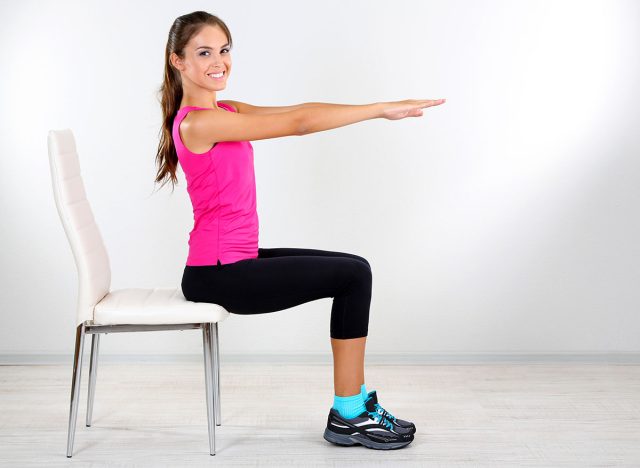
Think short, consistent sessions:
- Do all 5 exercises as a circuit
- Perform the required reps/time
- Rest, then repeat 2–4 times
- Three to four days per week is ideal
- If you already walk, bike, or strength train, add these on at the end as a 10-minute finisher
When You’ll Start Seeing Real Changes
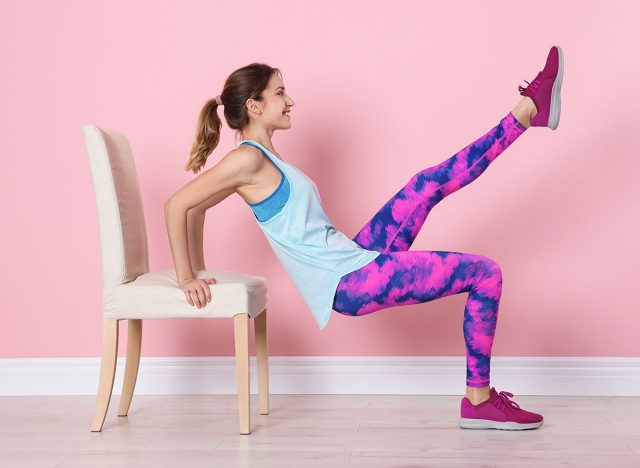
In the first 2 weeks: You’ll likely feel changes—better posture, stronger core, less strain in your back.
In 4–6 weeks: Visible results in the midsection usually show when these exercises are paired with regular walking, strength training, and mindful nutrition.
Remember: consistency beats intensity, especially after 50.
Looking for easy ways to lose fat? Here’s How Long Your Walking Workout Should Be To Shrink Belly Fat.